Estimated reading time: 14 minutes
The ranch rifle. It is a niche category of long gun meant to fill a utilitarian role whether it’s on a ranch, on the farm, or anywhere in the great outdoors where being armed can come in handy. But niche and utilitarian probably should not be used in the same sentence together. Enterprising gun manufacturers have built lines of guns with their own notions about what a ranch rifle would be.
Some models even borrow the term and, for some, fit the bill very well. But more often than not, what constitutes a good ranch rifle is a synthesis of covering a wide variety of tasks with a platform that is appropriate for the shooter and the environment in which he or she operates.

As a gun owner who has a hand in the hunting and farming world, I have seen my share of rifles that defy and define the type. Follow along as we explore what constitutes a ranch rifle, what criteria to consider, and a few competing options to open the door to your ideal ranch rifle.
Table of Contents
The History of the Ranch Rifle Concept
The concept of a ranch rifle is nothing new, but it is linked to trends in hunting rifles. This harkens back to the smoothbore flintlock most Americans were armed within the 18th and early 19th centuries. Rifles were a truly niche option and an expensive one at that. The smoothbore functioned like a shotgun today and could take any small or large game to put meat on the table, drive foxes out of the hen house, and defend against two and four-legged predators with a simple change in ammunition.
As rifles grew in popularity, the favorite hunting rifle became the tool that is the ranch rifle. Although it may not have been appropriate for every task, it was made to fit those tasks. But day in and day out, the rifle was called upon most often to control pests and predators. 1
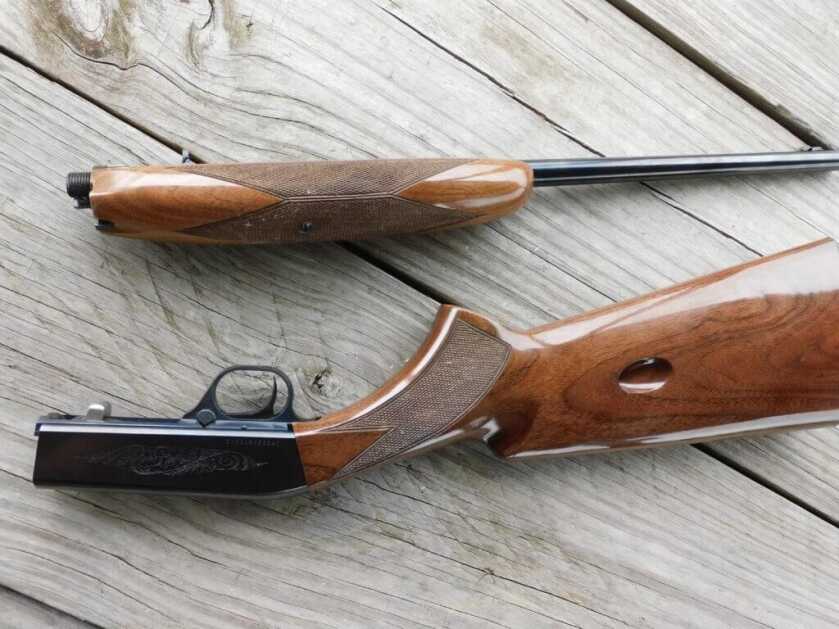
Ranch Rifles Evolve
At the turn of the century, deer were almost extinct in the Eastern United States and shots were relatively close. Any number of .22 rimfire rifles would suffice. Out West, the dangers were hardened and the distances greater and the same guns that won the West, like the Winchester lever action and falling block single shot rifles like the Remington Rolling Block and the Winchester 1885 High Wall, continued to serve the double duty of defending the homestead and putting meat on the table. The ranch rifle was simply the gun on hand that could do both.
This weapon of opportunity was reflected by Theodore Roosevelt in Hunting Trips of a Ranchman from 1885 chronicles the nature of the rancher as a seeker of danger and opportunity as those “who perforce lead an open-air life, who must needs ride well for they are often in the saddle from sunrise to sunset, and who naturally takes kindly to that noblest of weapons, the rifle. With such men, hunting is one of the chief pleasures; and they follow it eagerly when their work will allow them. And with some of them, it is at times more than a pleasure. On many of the ranches-on my own, for instance–the supply of fresh meat depends mainly on the skill of the riflemen.” 2
What Did You Need It For?
Then, like now, the circumstances dictate the equipment. The ranch rifle was increasingly defined as a tool of opportunism that was cost-effective. For most, it was the hunting rifle, possibly the only firearm in the household. The definition of the ranch rifle began to change as hunting rifles changed. Particularly as hunters chased military surplus rifles and their civilian facsimiles after the Second World War.
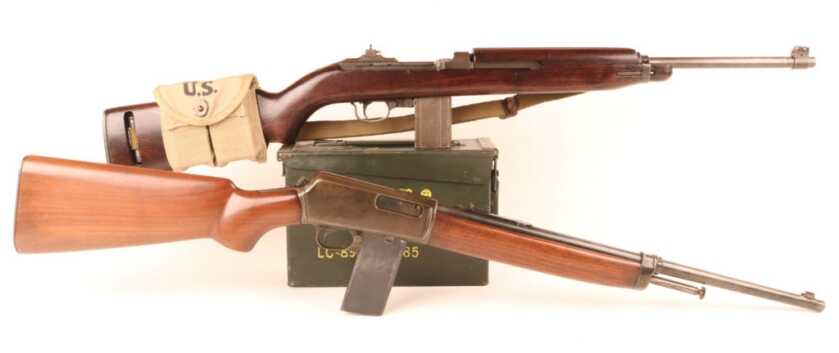
After a sixteen-year-long stint surviving the Great Depression and earning wages during the war without any capacity to spend it, the Greatest Generation went on a spending spree and they sought the arms they were familiar with. The ubiquitous single shots and lever actions were supplanted by bolt action rifles. The market had these in quantity with surplus Springfields and Mauser bring-backs. The M1 Carbine was the most produced weapon of the war. Surplus carbines were introduced to the American market as semi-automatic firearms with detachable magazines.
The Carbine was so popular that civilian manufacturers picked up the design. 3The .30 Carbine round it used was more potent than rimfire ammunition, but would not batter around the shooter like conventional rifle rounds such as the 8mm Mauser or the .30-06. For close shots on bigger game and rapid follow-up shots on fleeing pests, the M1 Carbine proved to be a contender, but it was the pinnacle of a niche dominated by hunting rifles of all stripes.
Available on GunsAmerica Now
New Ranch Rifles Setting The Standard
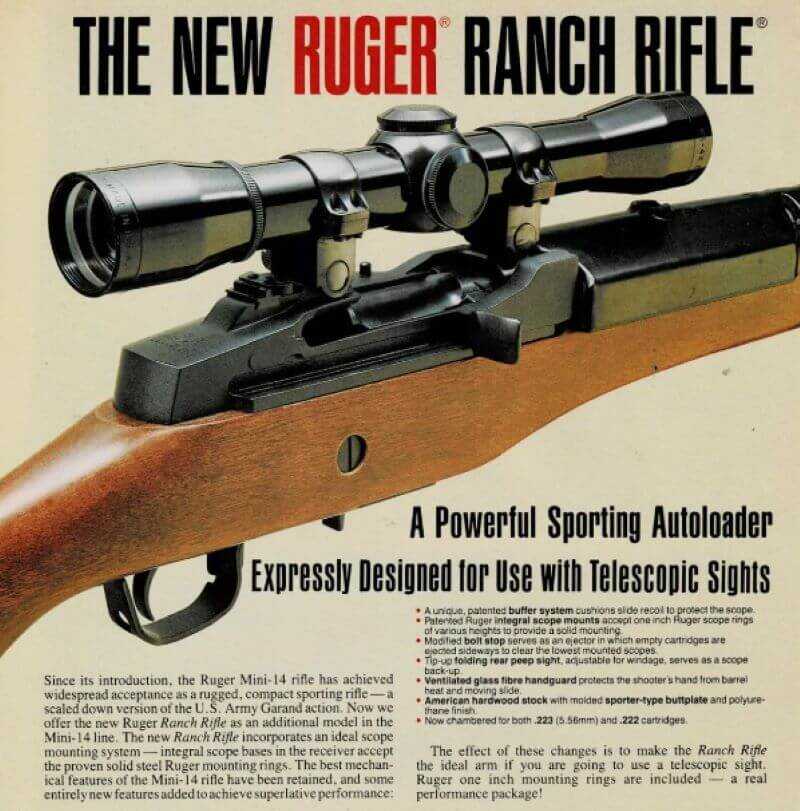
The Ruger Mini 14, introduced in 1972, upped the ante by giving the American public a semi-auto facsimile of a familiar military rifle, but in a cartridge that had better range and potency than the .30 Carbine. The Mini was chambered in .223 Remington and used detachable 20-30 round magazines. The .223 was developed for the US military in 1963. At its introduction, it was billed as a varmint cartridge. The Mini has a reputation for being a tactical carbine in a traditional guise. Yet it was originally marketed as an outdoorsman’s rifle. That was hammered home when the Ranch rifle version debuted in 1982. It had improved iron sights, an integral scope base, and scope rings. 4
The Ruger Mini 14 Ranch rifle became a catch-all light rifle that was versatile and powerful enough to fight, hunt, and control pests at reasonable ranges. The expiration of the Clinton Assault Weapons Ban in 2004 saw the market flood with AR-style rifles. The modern AR seems like the antithesis of what we once called a traditional rifle. Some makers try to embody that spirit. Rifles like the Sig MCX Regulator, the Foxtrot Mike Ranch Rifle, and the CMMG BR4 retain some of that traditional stock profile but incorporate AR modularity so the user can modify the rifle as he or she suits. 5
A New Default
While the AR has since become a default rifle and a standard by which others are judged, it is far from the only platform competing in that ranch rifle niche, either by name or by function. The Ruger Mini 14 remains a favorite and lever action rifles have enjoyed a resurgence. Lightweight bolt action rifles, and the advantageous higher-power cartridges they fire, have also enjoyed renewed interest.
The Ruger Gunsite Scout, a homage to Jeff Cooper’s scout rifle concept, has its share of fans. CZ’s series of iron-sighted and optics-capable Mini Mausers like the 527 and the CZ 600 Alpha bring Euro craftsmanship to the traditional short-action bolt gun concept. 6 But it is the budget-friendly Ruger American Ranch rifle that directly chases the diction. This short-action shorter-barreled rifle fits the light, quick bill and is available with extended magazines. 7
What Makes a Good Ranch Rifle?
If history tells us anything, it is that a ranch rifle has always been a do-it-all platform. It often does not fit existing categories, but more recent market trends prize caliber-effectiveness, handiness, and weather resistance above other considerations.
Ideally, a ranch rifle should be in a caliber appropriate. But what is the best ranch rifle caliber? Handiness and weather resistance are fairly hard and fast rules. But caliber comes down to the party line answer of: it depends.
Caliber
An AR platform in .223 is an excellent fighting rifle and good for combatting pests. Not as much of a bear rifle if you live in bear country. A lever action in .45-70 can do well in the latter category, but it could be overkill if your day-to-day routine involves chasing foxes and snakes out of the hen house where a simple .22 rimfire will suffice.
None of these have the easy reach of higher powered bottleneck cartridges like 6.5 Creedmoor, .308 Winchester, and .30-06, where the ranges grow longer on game and pests that are bigger. On the other hand, you might skip these and smaller rounds like the .223 if you are hunting small varmints that have to be hit from extended ranges. The ideal ranch rifle could be a Marlin 1895 in .45-70 for one. Or a stock AR for another, and a .22-250 varmint rifle for another.
Weight and Construction
Likewise, many outdoor activities require you to work around equipment and carry much more gear than you are likely to use. A heavy varmint or target rifle is an excellent option when sitting and waiting. It would be onerous to carry around though. A ranch rifle should be light enough so that it is not left behind.
On that same token, the ranch rifle should be reasonably hearty. It should not be so light that it is unsteady in the hand. Yet not so flimsy that it cannot take some abuse. Nitride and melanite finishes as well as stainless steel and aluminum construction have created rifles that can take more neglect from the elements. Wood and steel guns serve perfectly in the ranch role. More modern finishes can better tolerate rain, mud, dust, and the repetitive motions of coming in and out of a scabbard of behind the headboard of a truck.
The problem with this trifecta is that it sometimes does not pan out with the kinds of firearms we have available to us. While there are rifles marketed as ranch rifles, the particulars may not always line up with what you want. But there are quite a few that can fit the bill if you know what you are looking for.
Best Ranch Rifles
In the end, there is no true top ranch rifle to pick. There is only a top pick for you. But based on GunsAmerica sales, industry trends, and some of our writers’ recent endeavors, here are a few models to consider.
Ruger American Ranch

The Ruger American Ranch rifle sets the category for a reliable bolt action platform. It is just nimble enough to split the difference between a pest control rifle and a defensive rifle. It chambers intermediate cartridges from the varmint dusting .204 Ruger to the big game-worthy .450 Bushmaster. Regardless of caliber, it features a short 16-inch barrel and a Picatinny rail for mounting a traditional optic or a reflex sight, depending on the ranges you expect to shoot. This versatility is matched with extended capacity magazines ranging from 5-20 rounds.
Henry Big Boy Carbine
If you are interested in a rifle to match your handgun, lever action rifles like the Henry Big Boy Carbine are tough to match. The Big Boy series is available with either a brass or steel receiver. Both wear standard semi-buckhorn iron sights and are tapped and drilled for a Weaver scope base.
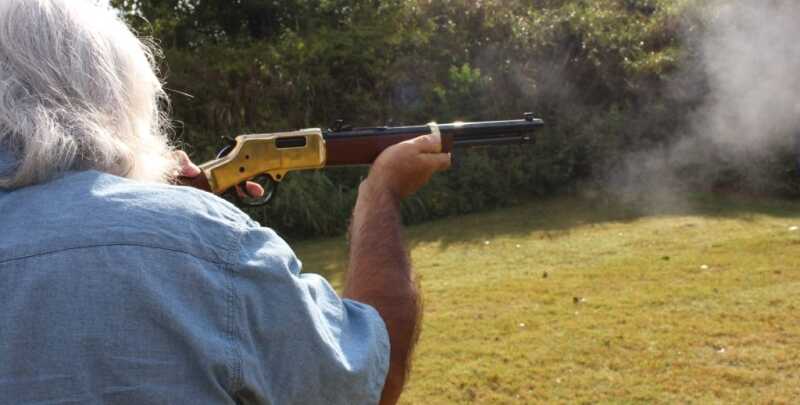
No matter the style, this handy 16-inch barreled lever action is not picky on ammunition. It can be cycled with a flick of the wrist. The Big Boy Carbine has a capacity of up to seven rounds of .357 Magnum, .44 Magnum, or .45 Colt, all of which can be loaded down for discreet pest applications and loaded up to take big game inside 100 yards.
Ruger Mini 14

The Mini 14 formally launched the ranch rifle category when it first came out and it remains a viable option. It has only gotten better in time. In 2005, Ruger improved the barrel manufacturing process for the Mini to address accuracy issues with the original models.
The new Minis are more accurate and have a growing aftermarket for stocks, scope rails, and accessory attachments. But it is still a solid autoloading platform available in different stock configurations and barrel lengths, as well as a few different calibers from 5.56 NATO to 7.62x39mm. But in terms of style and overall functionality, the Mini 14 Ranch Rifle with an 18.5-inch barrel checks all the boxes and is legal in more areas compared to other models.
Marlin Model 1895 Trapper
The Marlin Model 1895 filled the ranch role long before it was commercialized. It was introduced as a heavy frame lever action by Marlin in 1895 to handle large-bore black powder rifle rounds like .40-82 and .45-70.

For decades, the various versions of the Model 1895 in .45-70 have been the choice for big game timber hunters and even outdoor guides in bear country. Today, Marlin continues to make a blued steel and walnut stocked version as well as a railed Dark series model. The all-stainless model with laminate stock and a 16-inch barrel gets the nod for weather resistance and overall handiness.
Sig Sauer MCX Regulator

The Sig Regulator is an AR platform with a traditional buttstock. The Regulator features an aluminum M-Lok handguard and a matching aluminum upper and lower receiver. It features a 16-inch barrel and a three baffled muzzle break. The Regulator is piston-driven and is available in either 5.56 NATO or the larger and legal in more places 7.62×39.
Henry Small Game Carbine
Centerfire rifles usually come to mind when considering a ranch rifle. You can get a lot of mileage out of a .22 rimfire. Although hunting bigger game and taking out pests at a few hundred yards is beyond the little .22 LR or .22 Magnum cartridge, both work well for euthanizing livestock, small game hunting, and pest control in situations where a big boom or a big hole is undesirable. There are plenty of good semi-auto and bolt action .22 rifles on the market. A good lever action is handy though, and can cycle low-powered rounds like subsonics and ratshot.
READ MORE: Cold War Classics Reborn
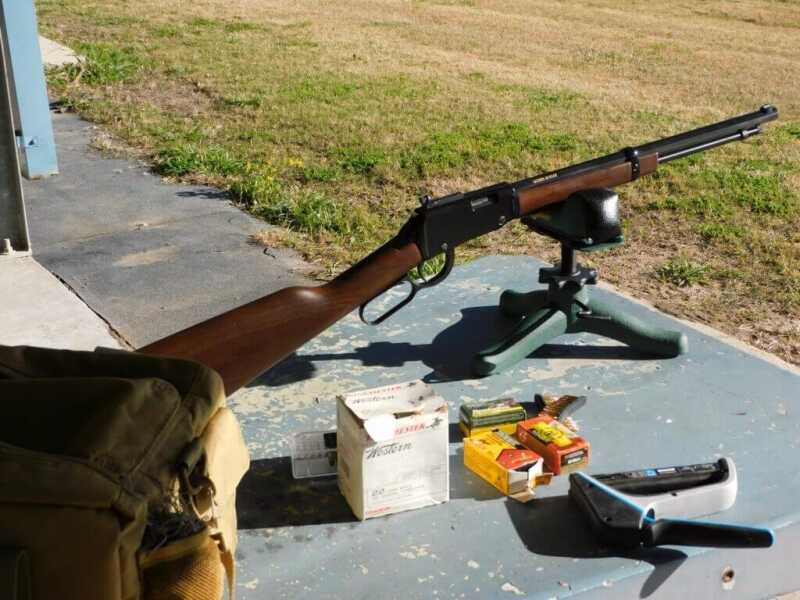
Consider any number of Henry lever action .22s, but the Small Game Carbine gets the nod. Available with either a 16 or 20 inch octagonal barrel, this tube-fed .22 holds 12-15 rounds of .22 LR or 9-12 rounds of .22 Magnum–depending on the caliber and barrel length you choose. It has a full-length adult-sized buttstock and despite its octagonal barrel, it weighs just over six pounds naked. The rifle comes with a Skinner rear-peep sight that is intuitive to use compared to conventional semi-buckhorn sights. It is also railed for a 3/8 inch scope ring to add some magnification if you choose it.
References:
- The Best Rifle for Farm and Ranch – Countryside (iamcountryside.com) ↩︎
- Roosevelt, Theodore, Hunting Trips of a Ranchman: An Account of the Big Game of the United States and Its Chase with House, Hound, and Rifle, (New York: Knickerbocker Press, 1885), 34-35. ↩︎
- NRA Blog | The M1 Carbine: America’s ‘Light Rifle ↩︎
- The Ruger Ranch Rifle – More Accurate Than Ever – RifleShooter (rifleshootermag.com) ↩︎
- Sig Sauer 5.56 MCX-Regulator Semi-Auto Rifle Review | Hook & Barrel Magazine (hookandbarrel.com) ↩︎
- CZ 600 American Review | Outdoor Life ↩︎
- 300BLK Ruger American Ranch Rifle: A Perfect Suppressor Host (gunsamerica.com) ↩︎
*** Buy and Sell on GunsAmerica! ***












Depends upon geography. South Texas near the border is whole different thing. You better be armed to face two legged threats.
Look up the definition of “extant”. It means the opposite of what you think it means.
I saw that, too. Did he mean they were in great abundance, “deer were almost extant in the Eastern United States”, or that they were almost extinct, just hangin’ on? Regardless, he is a good writer, broaches interesting subjects, and generally knows his stuff very well.
IMO, a good ranch rifle is a lever-action with iron sights. It’s handy, accurate enough out to 150-200 yards with iron sights, and can take a bit of a beating and keep on sluggin’. Honestly, a guy with a ranch rifle hanging in the back of his truck is not going to be taking 300 yard shots at game…the principle of a ranch rifle is that he is not taking out it solely to hunt antelope at 300 yards.
In my opinion a ranch rifle has two jobs. The first is to protect you and the second is to protect your property which immediately eliminates all rimfires. If you have 30+ acres and you see a pack of coyotes trying to take down one of your horses or cows 200+ yards away do you have what you need to stop them? That’s where you start in my opinion.
I agree 100%. Even though I don’t own a ranch or farm, I always thought the Ruger Mini 14 in .223, or better yet, 7.62X39mm, with a detachable magazine would make a fine light-weight ranch rifle easy to carry on horseback. Even something in .308 would be great. I had a Mini 14 in .223 once and it was pretty accurate out to 300yrds, but I personably think the .223 is a little underpowered for heavier animals, besides the ones illegally crossing our borders and committing murders in our country.
The nice thing about the AR platform is the availability to build something specific to your needs. There’s a plethora of powerful calibers available to fit all needs for anything you might run across in the US without having to jump into the larger AR10 platform. I have a suppressed 11″ SRB in .300 Blackout that will hit a pie-plate at 300yrds off-hand no problem with much more energy that a .223. Yes, it was a little pricy requiring 2 stamps, but I can built it long or short AND use the same ‘can’ on anything under .30 caliber. I have 5 uppers for it. Just pull the pin, swap it out, good to go!